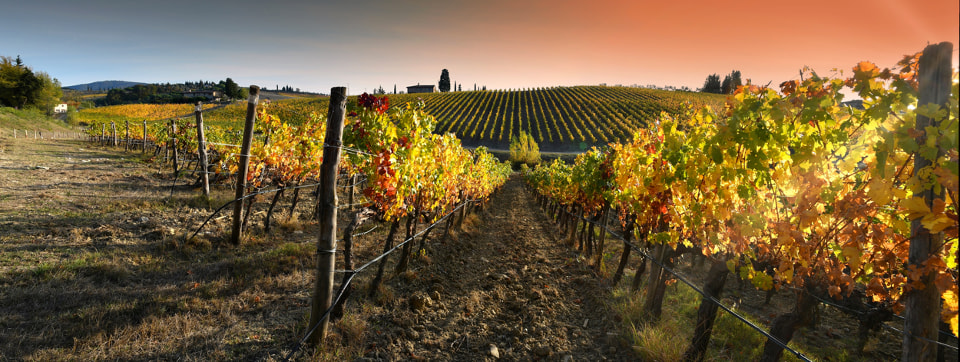
Chianti wine FAQs

Some European wine regions remain aloof to visitors, while others are slowly catching up. Chianti disarms and instantly seduces you. The iconic landscape which unfolds between Florence and Siena is arguably the most Instagrammable piece of paradise on earth. In July and August, the crowds can be both overwhelming and infuriating—sensible locals head to the coast. But in early spring and mid-autumn, Chianti is every bit the dream destination for a wine lover, not least because it produces a surfeit of delectable Italian reds.
Click on a link to jump to that section:
Which grape variety is the star of the Chianti show?
For centuries, tourism has been an important part of the region’s economic wellbeing. Yet the true mainstay of Tuscan life has always been the grape. With the major exception of the wine regions on the Adriatic coast, central Tuscany is Sangiovese country. Like Pinot Noir, Italy’s most famous viticultural export is highly sensitive to its environment. If the red grape is planted on inferior soils and made without due care, what emerges is astringent mouthwash. But the other side of the coin is sumptuous hedonism, top-quality Sangiovese competing with Cabernet Sauvignon for the title of the world’s best red grape. The question is: where can you find some brilliant examples?
Where is the Chianti wine region?
Although it does not hold a monopoly on sublime Sangiovese, Chianti Classico is the most trusted source of world-class red wines. The Chianti Classico appellation is located in the hills between Florence and Siena, with vineyards generally planted at altitudes of approximately 300-550 metres. This is Chianti Classico’s secret: at these (relatively) high altitudes, and in a climate which increasingly enjoys dry autumns, the cooler temperatures enable the tannins to ripen slowly and evenly. The end result is usually an approachable, concentrated and velvety wine style, which should age for decades.
However, Chianti Classico’s ‘recipe’ has changed considerably over the past 15 years. For most of the 20th century, Chianti wines typically contained a certain percentage of inferior white grape varieties. Of course, inferior is a relative, subjective term and some growers continue to cherish their plantings of Trebbiano Toscano. Nevertheless, there was a broad consensus that grapes like Trebbiano contributed little to the blends of Chianti Classico. Many critics regard the prolific white grape as a bland workhorse, with little distinctive flavour and personality. The authorities eventually responded to this long-standing criticism, by banning the inclusion of white grapes in 2006.
In our opinion, modern Chianti wines are all the better for it. The cult of the individual is alive and well in the Chianti zone, however, there are strict rules and regulations which ensure only the highest quality products can leave the region. If a producer wishes to label their wine as Chianti Classico, then the bottle must only contain red grapes. This is non-negotiable, although growers are given a certain amount of’ ‘wiggle room’. Chianti Classico is always made substantially (80%-100%) from low-cropped, top-quality Sangiovese vines, aged in wood before release. In addition, a small percentage (up to 20%) of other red varieties may be incorporated into the final blend. These include Merlot, Cabernet Sauvignon, and Tuscan grape Canaiolo.
What is Chianti’s signature scent and flavour?
Every good Chianti producer dedicates an enormous amount of time and energy to their vineyards. This is because Sangiovese, to put it mildly, is a difficult grape variety to cultivate successfully. It does not like too much heat, excessive rain leads to dilution, and the wrong soils cause overproduction and a loss of flavour. Moreover, the late-ripening, high-acid Sangiovese prefers sandstone terroir with good drainage. However, if the grape is cropped at low levels, then the winemaker has an enviable opportunity to fashion a savoury, complex, and aromatic wine style.
In the best vintages, the results are exceptional. The inherent freshness of the Sangiovese grape combines with ripe tannin to provide almost endless sensual pleasure. Premium Sangiovese is a joy to drink: aromas of cherry, fig, plum, damson, and black pepper emerge from the glass. The palate should always be full-bodied and generous, brimming with complex flavours. In fact, all that is missing is a ludicrous price tag.
What does the future of Chianti wine look like?
In 2021, Tuscany is poised to take stock of a revolution in its wines which began over 35 years ago. Chianti’s owners and winemakers have changed, probably forever, the face of a region with three millennia of history. Rules have been tightened and new categories introduced. White Tuscan varieties were once a ubiquitous part of Chianti Classico’s landscape, now they are rarely seen. The Riserva tier of Chianti Classico has been a particular success, providing growers with an unrivalled opportunity to market their best wines under an officially recognised quality seal.
But in the end, what matters most is that Chianti wines are getting better and better. The consistency of quality that is achieved today would have been unthinkable in the mid-20th century. Wine producers continue to refine and improve their viticultural and winemaking techniques. And, for the world’s consumers, there has never been the choice that is now available.




